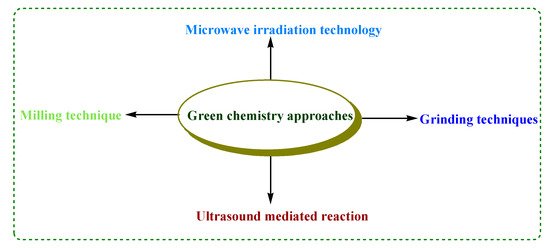Green synthetic protocol refers to the development of processes for the sustainable production of chemicals and materials. For the synthesis of various biologically active compounds, energy-efficient and environmentally benign processes are applied, such as microwave irradiation technology, ultrasound-mediated synthesis, photo-catalysis (ultraviolet, visible and infrared irradiation), molecular sieving, grinding and milling techniques, etc.
- drug
- green chemistry
- microwave
- oxadiazole
- synthesis
- biological activities
1. Introduction
2. Green Chemistry Approaches
Figure 1). By applying these technologies, organic reactions become more efficient and economic by enhancing the rate of reaction with reduced reaction time and high product yield. Synthetic approaches like grinding or milling techniques involve the application of mechanochemistry for the rapid, clean, efficient and solvent-free synthesis of various biologically active compounds [6].

Figure 1.
During the year 1991, the Environmental Protection Agency (EPA) and the National Science Foundation (NSF) initiated the Green Chemistry Program. P.T. Anastas and J.C. Warner have formulated twelve major principles of green chemistry to reduce or eliminate the risk of chemical hazards and environmental pollution [7][8][9][10].
-
Prevention of waste or byproducts:
It is essential to carry out the synthesis in such a way that the formation of waste or byproducts is less or absent.
-
Atom economy:
It represents the design of synthetic methods to maximize the incorporation of reactants (starting materials and reagents) to get the final products
.

Figure 2.
The electrophilic-substitution reaction is very difficult at the carbon atom in the oxadiazole ring because of the relatively low electron density on the carbon atom. However, the electrophilic attack occurs at nitrogen if the oxadiazole ring is substituted with electron releasing groups. Similarly, the oxadiazole ring is usually resistant to nucleophilic attack. However, the halogen-substituted oxadiazole undergoes nucleophilic substitution with the replacement of halogen atom by nucleophiles [13]. Although 1,3,4-oxadiazole ring system was known in 1880, significant studies were carried out regarding its chemistry, structure, physical properties and application of its various derivatives from 1950 (
Table 1). 1,3,4-oxadiazole is a liquid with a boiling point of 150 °C. The percentage of C, H, N present in 1,3,4-oxadiazole is 34.29%, 2.88%, 40.00%, respectively [14].
Table 1.
 |
|||
|---|---|---|---|
| Angles | Bond Angle (°) | Bonds | Bond Length (Pm) |
| A | 105.6 | a | 139.9 |
| B | 113.4 | b | 129.7 |
| C | 102.0 | c | 134.8 |
- Use of less hazardous and toxic chemicals:
Various synthetic methods should be designed properly so that the use and generation of substances have less or no toxic effect on human health and the environment.
-
Designing of Safer chemicals:
The design of the chemical product should preserve efficacy while reducing toxicity.
-
Selection of Safer solvents:
Avoid the use of auxiliary materials (solvents, extractants) if possible, or otherwise, make them innocuous.
-
Energy efficiency:
Energy requirements should be minimized and conduct synthesis at ambient temperature and pressure.
-
Renewable feedstock:
Raw materials should be renewable.
-
Reduce derivatives:
Unnecessary derivatization should be avoided where possible.
-
Smart catalysis:
Selectively catalyzed processes are superior to stoichiometric processes.
-
Biodegradable design:
The design of chemical products should be in such a way that these can be degradable to innocuous products when disposed of
. -
Real-time analysis for pollution prevention:
Monitor the processes in real time to avoid excursions leading to the formation of hazardous substances.
-
Prevention of hazards and accidents: Materials used in a chemical process should be selected to minimize hazardsand risk for chemical accidents.
3. Chemistry of OxadiazoleMoiety
Oxadiazoles are five-membered heterocyclic compounds that possess one oxygen atom and two nitrogen atoms in the ring system [11]. Depending on the position of heteroatoms (oxygen or nitrogen), there are different isomeric forms of oxadiazole moiety such as 1,2,3-oxadiazole, 1,2,4-oxadiazole, 1,2,5-oxadiazole, 1,3,4-oxadiazole (
2
2
2O. Among these isomers, 1,2,3-oxadiazole is unstable and ring-opens to form the diazoketone tautomer. However, 1,3,4-oxadiazole is a thermally stable aromatic molecule and plays a major role in developing new drug candidates with diverse biological activities such as anticancer, antiparasitic, antifungal, antibacterial, antidepressant, antitubercular and antiinflammatory, etc. [12].
| D | |||
| 113.4 | d | 134.8 | |
| E | 105.6 | e | 129.7 |
2
1

Scheme 1.
The 1,2,4-oxadiazole was synthesized first time in 1884 by Tiemann and Kruger. Most of the oxadiazole synthesis is based on heterocyclization of amidoxime and carboxylic acid derivatives or 1,3-dipolar cycloaddition of nitrile and nitrile oxide [16]. Microwave irradiation can also be applied in the heterocyclization of amidoximes and acyl chlorides/carboxylic acid esters in the presence of NH
4
2
3
2
3 to produce corresponding oxadiazole derivatives [17]. Similarly, oxadiazole derivatives are produced by the reaction of aryl-nitrile with hydroxylamine hydrochloride to aryl-amidoxime inthe presence of a catalyst (MgO or CH
3
3
1
2

Scheme 2.
1
2
3
1
2
Scheme 3). The reaction was found to proceed smoothly under microwave irradiation within 25 min, whereas 12 h were required to complete the reaction under reflux conditions [20].

Scheme 3.
